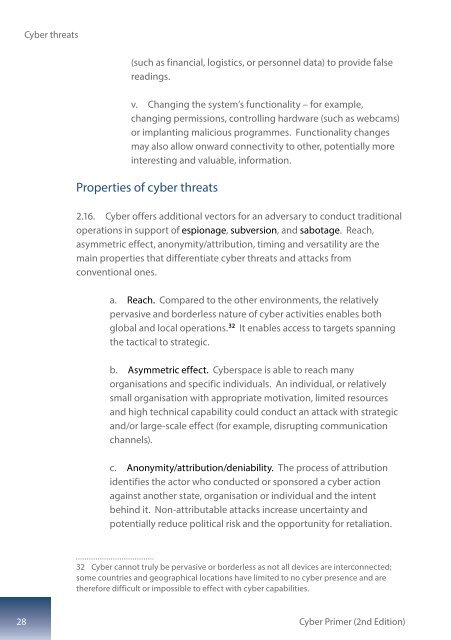Cyber Primer
AEWhbF
AEWhbF
You also want an ePaper? Increase the reach of your titles
YUMPU automatically turns print PDFs into web optimized ePapers that Google loves.
<strong>Cyber</strong> threats<br />
(such as financial, logistics, or personnel data) to provide false<br />
readings.<br />
v. Changing the system’s functionality – for example,<br />
changing permissions, controlling hardware (such as webcams)<br />
or implanting malicious programmes. Functionality changes<br />
may also allow onward connectivity to other, potentially more<br />
interesting and valuable, information.<br />
Properties of cyber threats<br />
2.16. <strong>Cyber</strong> offers additional vectors for an adversary to conduct traditional<br />
operations in support of espionage, subversion, and sabotage. Reach,<br />
asymmetric effect, anonymity/attribution, timing and versatility are the<br />
main properties that differentiate cyber threats and attacks from<br />
conventional ones.<br />
a. Reach. Compared to the other environments, the relatively<br />
pervasive and borderless nature of cyber activities enables both<br />
global and local operations. 32 It enables access to targets spanning<br />
the tactical to strategic.<br />
b. Asymmetric effect. <strong>Cyber</strong>space is able to reach many<br />
organisations and specific individuals. An individual, or relatively<br />
small organisation with appropriate motivation, limited resources<br />
and high technical capability could conduct an attack with strategic<br />
and/or large-scale effect (for example, disrupting communication<br />
channels).<br />
c. Anonymity/attribution/deniability. The process of attribution<br />
identifies the actor who conducted or sponsored a cyber action<br />
against another state, organisation or individual and the intent<br />
behind it. Non-attributable attacks increase uncertainty and<br />
potentially reduce political risk and the opportunity for retaliation.<br />
32 <strong>Cyber</strong> cannot truly be pervasive or borderless as not all devices are interconnected;<br />
some countries and geographical locations have limited to no cyber presence and are<br />
therefore difficult or impossible to effect with cyber capabilities.<br />
28<br />
<strong>Cyber</strong> <strong>Primer</strong> (2nd Edition)


